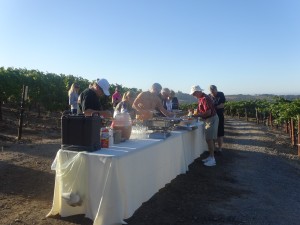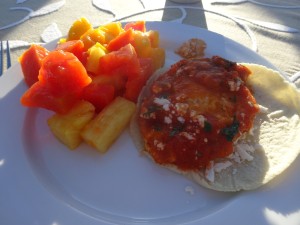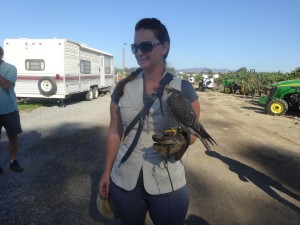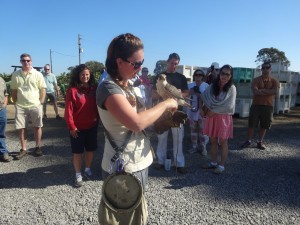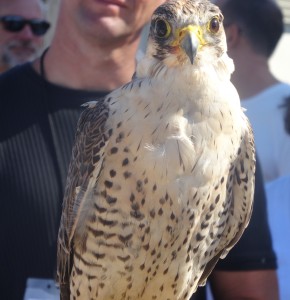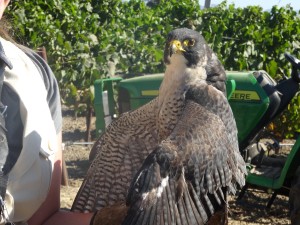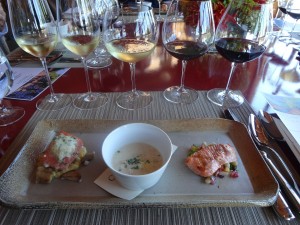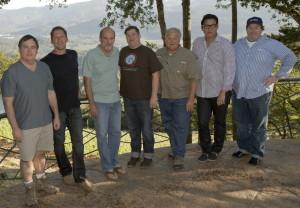We start day two of Cakebread’s American Harvest Workshop at Suscol Springs Vineyard ranch in south east Napa, where there are vineyards as far as the eye can see. I’ve never had breakfast in a vineyard and this one is a treat – a Mexican breakfast, huevos with red sauce and tortillas. Day one was a great introduction and I can’t wait to see what today brings.
Mark McDowell, the chef from Hawaii, brought a gift with him – fresh strawberry papaya – yum! With full tummies we set off into the vineyards with Bruce Cakebread, who was at one time the head winemaker. He talks to us about Napa Valley – what makes it unique as a wine growing region, thanks to the soils and climate.
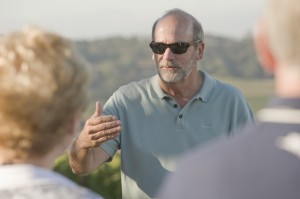
Hard to believe this ranch was a cattle grazing pasture up until 2007 when the Cakebreads planted Cabernet Sauvignon, Merlot, Cabernet Franc, Syrah and a little bit of Grenache. The Cab grapes are getting sweet! Bruce talks about sustainability and responsible agriculture, and talks about Napa Green Land, a vineyard certification that emphasizes best practices for sustainable farming to protect and enhance the land and the watershed. Cakebread’s Suscol Springs ranch was just recently Napa Green certified in August; it takes two to three years to earn that certification. Bruce also talks how important it is that he and his generation were given this great gift by the pioneers of Napa Valley, such as Robert Mondavi, Warren Winiarski who put the valley and its wines on the world wine map. He says it’s important to sustain what they have and to be good guardians so that they can pass the legacy on to the next generation. Did you know 90% of the 500 or so wineries in Napa Valley are family owned, and that about 74% of them produce 10,000 cases or less of wine each year?
Director of Vineyard Operations Toby Halkovich talks to us about the vineyard and the vines — how they manage them throughout the year, including all the data they collect on the soil and irrigation and adjust the farming to fit the current vintage weather patterns. We also learned that back in the day many vineyards were what’s called “field blends,” where instead of single varieties being planted in blocks, many varieties were planted in the same block. Sounds kind of haphazard to me, and shows the evolution of the knowledge gained by grape growers and winemakers over the past 40 to 50 years. Cakebread itself is 40 years old, so they have a lot of experience to build upon.
Our next stop is very cool. We arrive at the Milton Road Vineyard in Carneros, another Cakebread vineyard, to meet Rebecca Rosen of Authentic Abatement, who works with raptors in the vineyard for bird control. This is the time of year when the grapes start getting sweet and attract flocks of birds, mostly blackbirds and starlings, who descend upon the vines for a feast. There are many methods of bird control, from putting shimmering mylar streamers on the vines, to noise cannons to netting, but the Cakebreads feel having raptors patrol the vineyard is the most natural way to control birds and other rodents in the vineyard.
Rebecca introduces us to Ebi, a hybrid falcon, whom she has worked with for five years. She explains that having raptors flying around the vineyards breaks the pattern of the birds hanging around the vineyard to eat. They are scared off and will move on to the next food source. Ebi does several flybys and after his work is done he comes in for quite the landing and his reward, something to eat. Rebecca has brought several of the raptors she works with to show us, and we also get another demo from a pure peregrine falcon, Rambo, who flies higher and faster. It’s an impressive show!
There are all these other ancillary businesses that you never think about that support the wine industry. It’s not just food purveyors, it’s small businesses like Rebecca’s that benefit from wineries too.
We’re back at Cakebread for a session on food and wine pairing with Michael Weiss, who Bruce Cakebread calls “a fixture” at the American Harvest Workshop. It is amazing to me that so many people have been involved in this program for so long. I’m beginning to see why. The Cakebreads are showing their passion not only for winemaking, but for the culinary arts and all that goes in to making a winery successful over the long term. They have invested tremendous amounts of time and money into sharing not only what they do, but sharing their discoveries in all the wine related businesses, and this helps everyone. We the end consumers are richer for this shared knowledge and resources.
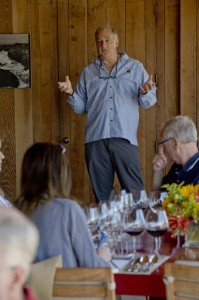
Michael is Professor of Wine Studies at the Culinary Institute of America at Hyde Park in New York. He’s worked as a sommelier and has written several books on wine. This guy is an amazing authority on wine and it is cool to have him here teaching us — I never stop learning about wine. As a wine professor, he trains young palates to approach wine from both an analytical view and a passionate view. He talks of a “tower of power” when it comes to matching food and wine, going from lightweight, light bodied foods and wines to more complex and flavorful ones. It makes sense and is easy to understand; no pretense here.
Michael tells us there has to be respect for the wine, room for the wine and food to co-exist, without one overpowering the other. You have to consider texture, cooking methods (poaching vs. grilling), sauces, grains and vegetables served with the main star on the plate. Fat and blood in meats balance tannins in red wine and so do mushrooms; on the other hand more tannic red wines can take on rosemary, fat and salt much better than other wines. Michael tells us if we learn one thing from him, remember this: when you are at a winery or with friends and want to impress them with your wine knowledge, swirl and sniff your glass and say one word: complex. Easy enough — but we’ll remember more thanks to his easy way of teaching.
We get to test out these guidelines over lunch. The first course is salmon and corn three ways – slow roasted salmon with creamed corn, smoked salmon corn chowder and grilled salmon. Michael says he loves corn and Chardonnay together, and salmon and Chardonnay is a classic. We have three Chards, a 2011, at 2010 reserve and a 2009 single vineyard. Michael encourages us to experiment and try each wine with each of the three salmon bites. Some work well, some work really well, some I don’t like together as much.
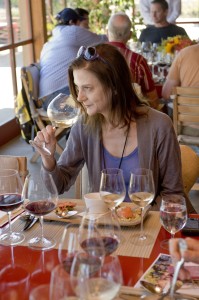
My favorite is the single vineyard Chard, not quite as rich as the reserve Chard and I thought a better match for most of the salmon dishes. Others liked the reserve Chard best. We move on to Pinot Noir and a Syrah, this time paired with duck three ways, grilled and a preparation called crepinette (a type of sausage not a crepe) and duck in a black bean chile. Again, we look for matches along the lines of texture, body and flavors.
Right after lunch is the menu planning session for the first big dinner tomorrow night. The chefs toss out ideas, Michael offers suggestions on ways to make the dishes pair best with the wines. Already it sounds like it will be an awesome meal.
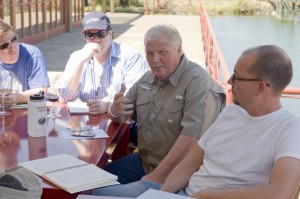

After a long afternoon break, we take a drive up Howell Mountain, one of the AVAs in Napa best known for powerful Cabernet Sauvignon. Our host tonight is Dennis Cakebread, who tells a great story about how his family’s Dancing Bear Ranch vineyard got its name. Seems something was eating the grapes, but they couldn’t figure out what kind of critter was doing it. Dennis came up with the idea of installing a motion activated camera to catch the animal in the act. But one camera wasn’t enough. He bought 10 to 15 cameras. Try explaining that to the winery accountant. Finally they got proof on film, black bears digging under the fencing to get to the grapes. Out of homage to their nocturnal visitors, the vineyard was dubbed Dancing Bear Ranch. The wine itself is powerful, full of cocoa and dark black fruits. The 2003 vintage tastes fresh and fruity, hard to believe it is a 10 year old wine; it is still a youngster.
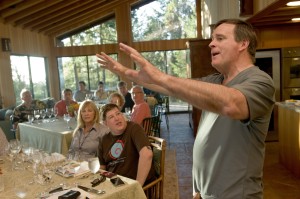
Dennis is not only a great story teller, but he’s got great one liners. When asked ‘when should you drink this wine?’ his answer is ‘when you have a corkscrew and a glass.’ In response to oak in wine he says, “we are not Chateau 2 x 4.”
It’s a wonderful evening at a property most people don’t get to see. I can feel the group gelling and we’re all feeling quite lucky to experience this place and this meal together. As a souvenir we get special Dancing Bear Ranch t-shirts. Dennis tells us you can’t buy them anywhere, you have to be here to get one. I feel like we are in the club!

